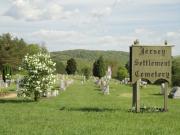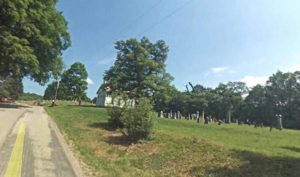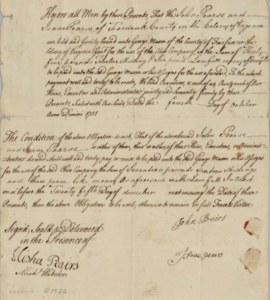by
Larry Pearce
12/28/18
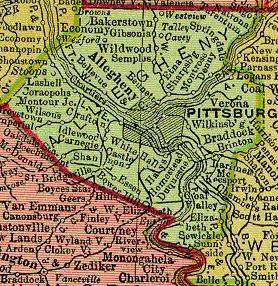
Allegheny County, PA (green) with the old Jersey Settlement at Elizabeth & Sewickley (lower RH corner)
When I began researching family history almost 20 years ago, the phrase “Jersey Settlement” in association with the various spellings of the Pearce surname in Allegheny County continually cropped up. Only recently has a close reading of the 1906 History of Bedford and Somerset Counties also revealed a possible connection to another Pittsburgh area Pearce-associated family: Moon. Ironically, the later investigation began to find pockets of one of my wife’s Somerset County Miller-associated families: Baer. The questions arose, “Were there ever any earlier meetings of my British Pearces and Moons and her Swiss-German Baers in association with what came to be called The Jersey Settlements?” and “Were the Somerset County Moons related to our Henry Moon (before 1760-after 1821)?” Family lore has it that, after being drafted in 1777 for service with General Burgoyne aboard The Royal George for the British Royal Artillery, he was able to escape around the time of the Battle of Bennington waged against the American colonialists. There is a vast amount of information available under the search phrase “Jersey Settlement,” but readers are advised here that there are several early communities under that name: at least three, as we shall see, in Western Pennsylvania, another in Ohio, and yet another in North Carolina, each with a fascinating collection of facts that can give us great insight into life on the various American frontiers. For this piece, however, our coverage will be limited to those in Somerset and Allegheny Counties of Pennsylvania.
First, it should be noted that the vast majority of our families’ immigrants came through or around New Jersey, so in a sense, any community in Western Pennsylvania could be considered a New Jersey settlement. The exceptions would be folks who came up the Ohio River or down from Canada, the Great Lakes, or NewYork State. Most sailed into New York City or Philadelphia before heading west. The only question at this point is where and for how long they stayed in what we’ve come to call “down East.” Some of the routes to Somerset County and Pittsburgh include the upper Susquehanna River to the northern Allegheny or Juniata Rivers past Fort Roberdeau to the Frankstown Road at present-day Altoona into Johnstown and eventually Pittsburgh. Much of this route became the Allegheny Portage Railroad, the first major route through the mountains, a combination of railway and canal barges to Pittsburgh. Today, Routes 322 and 22 and the Mainline of the Pennsylvania Railroad through the famous Gallitzen Tunnel follow a similar path.
Just to the south, the Forbes’ Road was the most direct route from the British settlements in the East to Fort Pitt in the West. Finished in 1758, it was the project of General John Forbes to drive the French out of the upper Ohio Valley, and much of it followed old Indian paths. I believe that my late-arriving Pearces (1820) took that route. It became Rt. 30, the Lincoln Highway, which is parallel to most of the Pennsylvania Turnpike.
Yet a third major way settlers came to Western Pennsylvania was what became known as the National Road from Philadelphia south to Delaware or the port of Baltimore, through the steep gap at Cumberland, Maryland, to Pittsburgh. Some call it Braddock’s Road, after General Edward Braddock’s failed attack on the French Fort Duquesne in 1755. Today scenic Rts. 40 and 51 and I-68 follow portions. We believe this third path to be the one the two Jersey groups we discuss here took.
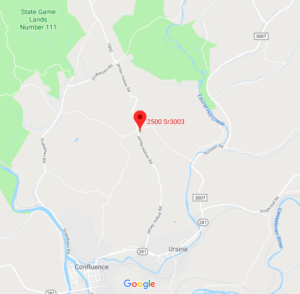
Jersey Settlement site, Somerset Co., PA
(Notice the rivers at Confluence form a turkeyfoot; Ursina was the original Ream/Baer property)
We begin with the Jersey Settlement in Somerset County, Pennsylvania, even though there’s only one of my family names associated with it: Moon. Later, my wife’s Baer family namesake becomes involved. This account comes from several venerable tomes, one compiled in 1906, History of Bedford and Somerset Counties, and another, a compilation of sources on the Pennsylvania Genealogy website for Somerset County. Residents there had come from what was considered as “rather a poor country,” Essex and Morris Counties, New Jersey. Today, the community between the Allegheny and Laurel Hill Mountains includes Draketown in Lower Turkeyfoot Township and the boroughs of Ursina and Confluence. We should say here that the name “Turkeyfoot” comes from the shape the three rivers make as they come together in the small town of Confluence. Though white hunters and trappers had roamed this rugged landscape for years, legend has it that an Indian scout for George Washington had coined the concept in 1753 to describe a possible path to Pittsburgh.
Just 17 years later, some 18 or 20 families left the sand hills of New Jersey for the Allegheny Mountains, which our sources describe as “Well-watered” with abundant game and timber and fertile soil. Their ox teams slowly wound their way through the mountains to this promised land. The History book says, “By mutual understanding among themselves, each was to be limited to such quantity of land as he would walk around in a single day, at the same time marking its boundaries by blazing the trees.” Yes, James Moon was one of the pioneers. He is listed as a Revolutionary War fighter. Our progenitor Henry Moon, as legend has it and as we said earlier, escaped his service to the British forces somewhere between New York State and Virginia to fight for the Colonialists. After the war he made his way to New Jersey, around 1785, to marry the widow of a Dr. Wilson. Together, then, they accepted Depreciation Land north of Pittsburgh where old Henry farmed and operated a Tavern. But, is our Henry Moon related to James Moon? There are many Moons in Western Pennsylvania. I grew up in Moon, Allegheny County, the oldest and at one time the largest in the area, founded in 1788. It’s uncertain whether it derived its name from a person or its shape along the Ohio River. Moon Township is located west of Pittsburgh and south of the Ohio River.
James Moon of the Somerset County Jersey Settlement was fortunate to see his son James and wife Elisha work a portion of the original acreage. Another, John Moon, is listed in church records there. So many others must have been disappointed to say goodbye to their offspring, lured away by the promise of the West. The legends of Draketown, named after Oliver Drake, and the village of Jersey, whose origin is self-evident, include Robert Colburn’s grist mill, one of the first in the region. Wouldn’t it be something if the ancestors of my Great-great grandfather Richard Pearce (1786-1861), a “miller by trade” according to our Original Family Narrative, had known the Colburns back in England. The Baptist church in the Somerset County Jersey Settlement was organized in 1775 with its first permanent structure built in 1788. William Lanning’s death by rattlesnake bite is recorded on his tombstone. The literal offshoots of Jon McNair’s fruit orchard are growing wild in the area even today. Tradition has it the William Tannehill was known to “sell” off portions of his estate to squatters for payment of “a gallon or two of whiskey and a grubbing hoe,” both precious commodities in those days. Stories of Indian raiding parties that drove those families into one of the two nearby stockades or blockhouses were part of the lore. Apparently no attack was enough to cause them to vacate their hard-earned land.
The Jersey Church, also known as The Turkeyfoot Baptist as it is still called, was the second oldest west of the Alleghenies and its two cemeteries today hold some 200 tombstones, including several for the Moons. The Baptist congregation held strict rules, and fortunately, a look at minutes from their meetings gives us much insight into life on the frontier. Today, thanks to the work of the folks at the Somerset County PAGenWeb Archives Tombstone Project, we have records of many of those old gravesites, including Jeremiah Moon, who fought for the Grand Army of the Republic in the Civil War, and several of his family. Unfortunately, the grave markings of the earliest Moons are gone.
As promised, the connection of the Somerset County Jersey Settlement to my wife Susan’s Baer family namesake, former 16th Pennsylvania Judicial District President Judge William J. Baer (1826-1908 of Swiss German descent with as yet undetermined relation to her Amish-Mennonite ancestors) provides an interesting insight into the richness of that area. As an investment in its mineral rights in 1868, Judge Baer purchased the large estate of John Ream (1764-1839), which encompassed what today is the area around Ursina, the eastern portion of the Jersey Settlement. Ream’s father Andrew (1737-1818) served in the American Revolution with the Lancaster Militia and possibly knew my wife’s ancestors Joseph “Yost” and Jeremiah Miller of Ephrata. Andrew’s father had reputedly come to Pennsylvania with William Penn in 1683. The Colonies surely must have seems to be a small “New World” back then.
The Somerset Jersey Settlers left Essex and Morris Counties in 1770. These municipalities lie just west of New York City. The Pittsburgh colony left Monmouth County in 1766. This eastern-most New Jersey area is home to Princeton University, about 400 miles from Western Pennsylvania as the crow flies. Another group from Morris County settled south of Pittsburgh in Washington County in 1778. One Lewis Pierce is recorded as the first person of this surname in that county. Of English descent, he was a farmer and devout Methodist, a “non-conformist” back in England and follower of John Wesley, like my Great-great grandfather Richard. Could Lewis and others have been remnants of either or both the first two New Jersey groups? Historian and descendant of the Pittsburgh pioneers, Elizabeth Wall, believes the Monmouth group crossed the Delaware River at Trenton, which delivered them right into old Philadelphia. From there, taking the Old Swedes Path, or King’s Road, they went south to New Castle, Delaware. Migrating directly west, across near what is now the Mason-Dixon Line, they crossed the upper Potomac to Fort Frederick and eventually came to present-day Cumberland on Will’s Creek. Remember that Virginia claimed all land west of Delaware and south of Pittsburgh, some even after the famous surveyors established boundaries. Following what was known as Glades Path the settlers would have come close to where the Turkeyfoot Jersey-ites had stopped. They proceeded into present-day Westmoreland County and eventually Forward Township, near the fort at Redstone on the muddy Monongahela River.
Other descendants, Allen and John Sutton Wall, wrote in 1888 that only seven men, in-laws Applegates and Walls, made the first trip over the mountains, leaving their families behind. This article says that the Walls stayed for a time at Frederick before being joined by the Applegates and moving on along Braddock’s Road to Western Pennsylvania. Be certain that this was a time of great tension between the Natives and the white men, who continually expanded their borders. The Walls’ article explains how careful these first settlers from Jersey had to be: “If they remained on their lands during this period, they doubtless kept very quiet and did not attempt to improve them further perhaps than clearing little patches for garden stuff near their cabins. Their food came mainly from the forest, which abounded in game and wild fruits.”
I recently discovered a 1751 contract between the American group of frontier explorers represented by George Mason of Fairfax, called the Ohio Company, and two men, John and Isaac Pearse, of Frederick, then in the Colony of Virginia. For the sum of 35 pounds, 12 shillings, and 6 pence, John and Isaac apparently agreed to settle near what we call Pittsburgh’s Three Rivers. The Company had been granted 200,000 acres in Western Pennsylvania just two years earlier by King George II of England. More research will be done on this, but surely these Pearses knew the Applegates and the Walls and were part of the Jersey Settlement at Pittsburgh.
Only after they were able to purchase their homes from the Indians in the fall of 1768 did they feel safe enough to send for their wives, children, and others. Within a year, we read of the arrival of our namesakes, James, Andrew, Jonathan, and Stephen (twins) Pearse, James Peers, and Joseph and John Pearce. We note here of the several spellings of my surname, Pearce. Historians say that this small area, now Forward and Elizabeth Townships, just north of the Mon River was known as the Jersey Settlement for a century. The 1858 volume, Monongahela of Old, and the collection of old land surveys in the University of Pittsburgh historical collection (digital), both available online, list some of the Pearce names & holdings along the Mon River:
–Jonathan & Stephen Pearce (twins), 252 acres surveyed March 21, 1786; patented January 21, 1788; called “Stephen’s Greene”
–Andrew Pearce, 324 acres surveyed September 17, 1785; patented May 26, 1788; called “Recreation”
–Andrew Pearce, 333 acres surveyed March 2, 1788; patented January 16, 1788; called “St. Andrew”
According to the 1889 History of Allegheny County, PA, the first families with my surname to settle in this western-most Jersey Settlement was Andrew Pearce/Pierce and James Pearse in 1769. Andrew’s name was also spelled “Peairs” in the cemetery records of the Round Hill Presbyterian Church . This is similar to the Pearse/Peairs blockhouse just north of Uniontown, PA, or what was known as Fort Burd or Redstone Old Fort. For more on Isaac Peairs (1730-1810), read the article, “Family Military Matters.” Andrew Pearce is recorded as having built the first grist mill at the Jersey Settlement. Again, was he part of or did he know my Pearce ancestors, “millers by trade”? For more on this and other particular early family namesakes, read “Pearce Lines: Part II.” You may also be interested to know that the very river boats that carried the Lewis and Clark expedition down the Ohio and into the West were constructed on the Mon River at adjacent Elizabeth Township in 1803. Another piece of history occurred in 1869, when Forward Township was officially formed and descendants of many of the original settlers there wanted it to be called “Jersey Township.” Politics got involved and the powers that were named the land after the former Secretary of the U.S. Treasury, Walter Forward. It is believed that he had never even been to that part of the State. The photo below shows a small piece of the modern industrialized Forward Township. The old Jersey Settlement farms are gone now, but despite the ever-growing commerce, the Township boasts of the lowest population density in a very urban Allegheny County.

Satellite view of Lock 3 on Mon River adjacent to Forward Township
(Notice the industrialization now)
In conclusion, many other fascinating stories are available of the Pearces, Moons, and other family namesakes associated with the various Jersey settlements in Pennsylvania. But the answer to the research questions posed in our introduction, after all this discussion, can be put this way: We just don’t know of any direct blood connections between our ancestors and any of the Jersey settlers. Our research continues in hopes of finding any possible genetic links between those families and ours who settled north of Pittsburgh in what we call North Park and McCandless and Pine Townships today. Unfortunately, time and space constraints have limited our coverage, especially to previous research and articles posted at E-gen.info, but by entering a search term or phrase in the appropriate window there, we’re confident that you’ll find additional information. As those early pioneers must have wished their friends, family, and neighbors often, in their quest to survive the hardships of life on the American frontier, so we say to you in typical Western Pennsylvania lingo, “Happy hunting.” Please don’t hesitate to share your findings with our readers in the space below.
DOCUMENTATION:
“Catherine Ream.” Minerd.com. 3 January 2019
http://www.minerd.com/bio-minerd,_unknownream.htm
Thomas Cushing, Ed. History of Allegheny County, PA. Chicago: A. Warner Co. 1889
https://historicpittsburgh.org/islandora/object/pitt:00afq9167m
E. Howard Blackburn & William H. Welfley. “The Jersey Settlement.” History of Bedford & Somerset Counties. New York: Lewis Publishing, 1906.Ch. IV, p. 21
https://archive.org/stream/historyofbedford03blac/historyofbedford03blac_djvu.txt
“Fort Burd-Redstone Old Fort. Usgwarchives.net. 3 January 2019
http://www.usgwarchives.net/pa/1pa/1picts/frontierforts/ff32.html
“Forward Township, Allegheny Co., PA.” Official website. 5 January 2019
http://forwardtownship.com
“The Jersey Settlement.” UH.edu. 23 January 2002
http://www.uh.edu/~jbutler/gean/jerseysettlement.html
“Lower Turkeyfoot Township.” Pennsylvania Genealogy Somerset. 2/1/19
http://www.pagenweb.org/~somerset/ltfoot/index.html
“Ohio Company.” Politico.com. 3 January 2019
https://www.politico.com/story/2017/05/19/ohio-company-granted-royal-charter-may-19-1749-238377
“Turkeyfoot Baptist Church.” Pa-Roots.com. 2 January 2019
http://www.pa-roots.com/index.php/pacounties/somerset-county/385-census-tax-lists-somerset-county/1550-turkeyfoot-baptist-church-2
“Plate 31-Forward Township.” digital.Library.Pitt.edu. 3 January 2019
https://digital.library.pitt.edu/islandora/object/pitt%3A14warp31/from_search/826e63c06657eaf7d283045dd1ff3f6a-0
Last revised 3/30/21

